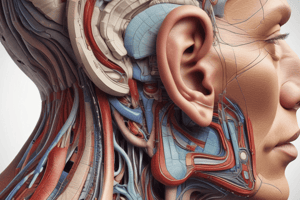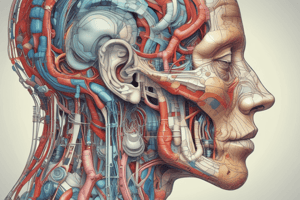Podcast
Questions and Answers
Describe the composition of the tympanic membrane and the orientation of collagen fibers within it.
Describe the composition of the tympanic membrane and the orientation of collagen fibers within it.
The tympanic membrane is made up of three thin layers of connective tissue, with collagen fibers oriented radially in the peripheral layers and concentrically in the central layer.
What are the components of the middle ear, and what type of epithelium lines the middle ear chamber?
What are the components of the middle ear, and what type of epithelium lines the middle ear chamber?
The middle ear contains a chain of small ossicles called the malleus, incus, and stapes, which are articulated with each other and associated with muscle tissues. The middle ear chamber is lined with a simple squamous or ciliated columnar pseudostratified epithelium.
What is the function of the cochlear duct, and how is it protected within the cochlea?
What is the function of the cochlear duct, and how is it protected within the cochlea?
The cochlear duct, a spiral structure housing the sensory organ for hearing, is protected by two perilymph-filled ramps or scales, the scala vestibuli and scala tympani, which communicate through a bony opening called the helicotrema.
Describe the lining of the cochlea and the structure involved in the production and metabolism of endolymph within the cochlea.
Describe the lining of the cochlea and the structure involved in the production and metabolism of endolymph within the cochlea.
What is the function of the organ of Corti, and what types of cells are included within it?
What is the function of the organ of Corti, and what types of cells are included within it?
How are the neuroepithelial cells categorized within the organ of Corti?
How are the neuroepithelial cells categorized within the organ of Corti?
What are the differences in the auditory canal structure between dogs and pigs?
What are the differences in the auditory canal structure between dogs and pigs?
What connects the external and middle ear internally?
What connects the external and middle ear internally?
Where is the middle ear located within the body, and what fills the bony chamber of the middle ear?
Where is the middle ear located within the body, and what fills the bony chamber of the middle ear?
What is the composition and function of the ossicles within the middle ear?
What is the composition and function of the ossicles within the middle ear?
What is the function of the inner ear, and what are its components?
What is the function of the inner ear, and what are its components?
What is the role of the helicotrema within the cochlea?
What is the role of the helicotrema within the cochlea?
Describe the structural features of pillar cells and their role within the cochlea.
Describe the structural features of pillar cells and their role within the cochlea.
Explain the composition and function of the tectorial membrane.
Explain the composition and function of the tectorial membrane.
What are the distinguishing characteristics of the vestibule, and what structures does it contain?
What are the distinguishing characteristics of the vestibule, and what structures does it contain?
Describe the orientation and composition of the utricle and saccule within the inner ear.
Describe the orientation and composition of the utricle and saccule within the inner ear.
Explain the role and composition of the otoliths within the inner ear.
Explain the role and composition of the otoliths within the inner ear.
What are the functions of the semicircular canals, and what structures do they contain?
What are the functions of the semicircular canals, and what structures do they contain?
Explain the arrangement and characteristics of cilia and stereocilia within the inner ear.
Explain the arrangement and characteristics of cilia and stereocilia within the inner ear.
What are the primary functions of the hair cells within the cochlea, and how are they associated with the tectorial membrane?
What are the primary functions of the hair cells within the cochlea, and how are they associated with the tectorial membrane?
Describe the composition and role of the Hensen's cells within the cochlea.
Describe the composition and role of the Hensen's cells within the cochlea.
Explain the function and composition of the organ of Corti within the cochlea.
Explain the function and composition of the organ of Corti within the cochlea.
What are the specialized receptors within the maculae, and what structures do they contain?
What are the specialized receptors within the maculae, and what structures do they contain?
Explain the functions of the inner ear, including its role in balance, orientation, and response to acoustic waves.
Explain the functions of the inner ear, including its role in balance, orientation, and response to acoustic waves.
Flashcards are hidden until you start studying
Study Notes
-
The length of the auditory canal and the sinuosity of light vary between animal species, with dogs having a longer structure and pigs having a more uniform one.
-
The auditory canal is closed internally by the tympanic membrane, which connects the external and middle ear.
-
The tympanic membrane is made up of three thin layers of connective tissue, with collagen fibers oriented radially in the peripheral layers and concentrically in the central layer.
-
The middle ear is located in a bony chamber, filled with air from the nasopharynx and lined with a simple squamous or ciliated columnar pseudostratified epithelium.
-
The middle ear contains a chain of small ossicles called the malleus, incus, and stapes, which are articulated with each other and associated with muscle tissues.
-
The inner ear is the portion where auditory and spatial sensations are collected, and is composed of the osseous labyrinth and membranous labyrinth.
-
The cochlea, which is part of the inner ear, contains the cochlear duct, a spiral structure housing the sensory organ for hearing.
-
The cochlear duct is protected by two perilymph-filled ramps or scales, the scala vestibuli and scala tympani, which communicate through a bony opening called the helicotrema.
-
The cochlea is lined by a simple squamous epithelium and contains the stria vascularis, a stratified epithelium involved in the production and metabolism of endolymph.
-
The organ of Corti, located on the floor of the cochlear duct, is an epithelial complex made up of neuroepithelial cells and supporting cells.
-
The supporting cells include five types: cells of Hensen, Deiter, outer phalangeal cells, inner phalangeal cells, pillar cells, and marginal cells.
-
The neuroepithelial cells are of two types: outer hair cells in three rows and inner hair cells in a single row.
-
Hensen's cells: tall columnar cells with few organelles, rest on basement membrane, define the outer tunnel, have basal nuclei and abundant cytoplasmic organoids.
-
Outer phalangeal cells (Dieter cells): very elongated, basal nucleus, abundant cytoplasmic organoids, excavation in apical area for corresponding hair cells.
-
Inner phalangeal cells: similar to outer phalangeal cells, house inner hair cells in apical area.
-
Pillar cells: triangular cells, wide base on basement membrane, thin conical body, configure inner tunnel, outer pillar cells attached to hair cells.
-
Marginal cells: columnar cells, form a row on tympanic lip of limbus.
-
Organ of Corti: neuroepithelial cells are hair cells, transformed neurons, elongated columnar cells, euchromatic nucleus, acidophilic cytoplasm, stereocilia in apical portion, embedded in phalangeal cells.
-
Structural features of hair cells: stereocilia in W pattern for outer hair cells, V pattern for inner hair cells, coupled to tectorial membrane, surrounded by mitochondria and smooth endoplasmic reticulum.
-
Basement membrane associated with presynaptic bulbs, formed by ganglion cells in fibers of the acoustic nerve, located below hair cells.
-
Tectorial membrane: formed from interdental cells, homogeneous, medium-density keratinized layers, associated with stereocilia, connected to bone tissues of modiolus.
-
Vestibule: hollowed area in petrous temporal bone, houses utricle and saccule, contains maculae, specialized receptors, and gelatinous cupulas.
-
Utricle: membranous diverticulum, contains macula saculi, hook-shaped, oriented vertically, covered with neuroepithelial cells.
-
Saccule: membranous diverticulum, contains macula sacculi, kidney-shaped, oriented horizontally, covers neuroepithelial cells.
-
Maculae: specialized receptors, contain neuroepithelial cells, supporting cells, gelatinous cupulas, and otoliths.
-
Cilia and stereocilia: arranged in cupula, type I cells are globose with highly developed type 92+2 cilia and stereocilia, Type II cells are columnar with large proportions of 92 +2 cilia and stereocilia.
-
Semicircular canals: originate from vestibule, host membranous semicircular canals, contain cristae ampullares, and are filled with cerebrospinal fluid.
-
Crystals (otoliths): polyhedral concretions of calcium carbonate, located in apical area of cupula, beneath hair cells.
-
Functions: sense balance and orientation, respond to acoustic waves, transmit vibrations to the chain of ossicles in the middle ear, and to the round window in the cochlea.
Studying That Suits You
Use AI to generate personalized quizzes and flashcards to suit your learning preferences.




